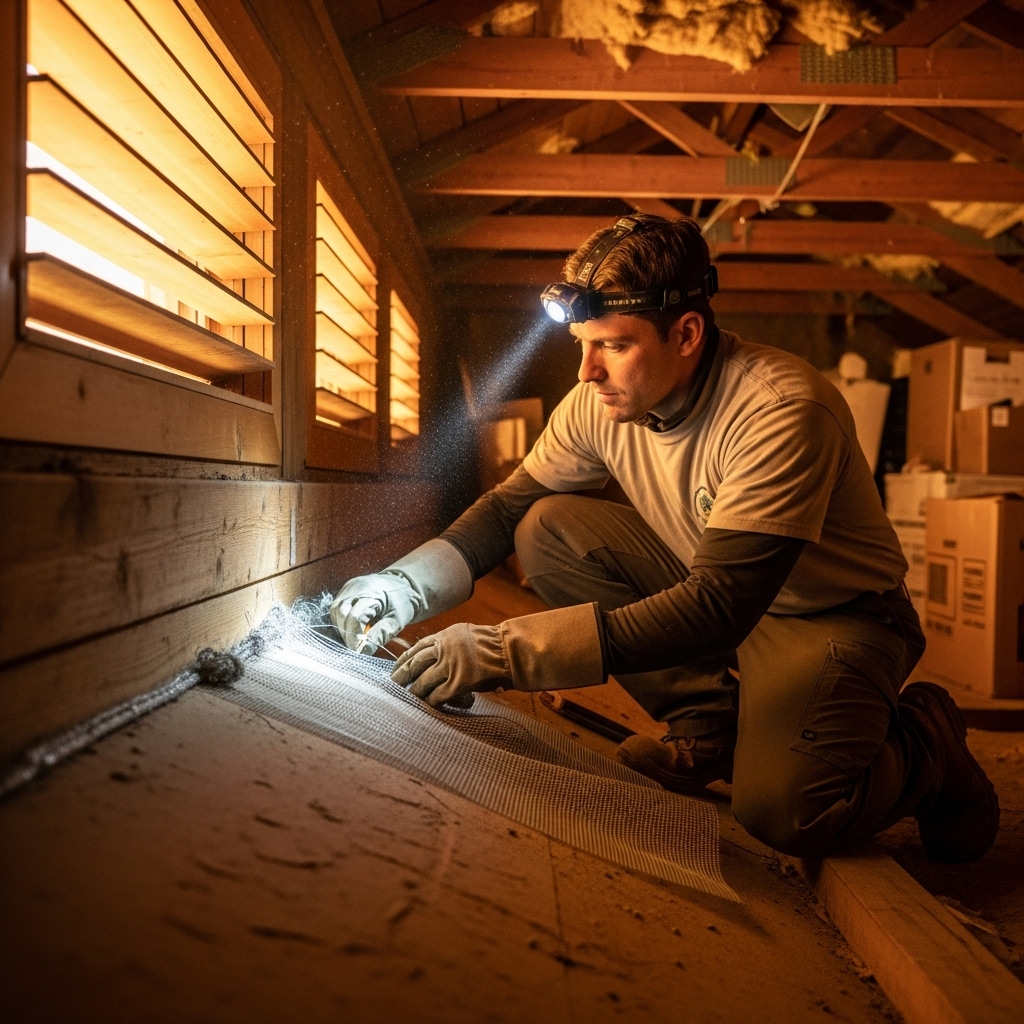When you live in Los Angeles, you get used to the constant rhythm of the city: ocean breezes that carry a hint of salt into Santa Monica, canyon winds that whisper through the Hollywood Hills, and warm valley nights that make every backyard feel like an outdoor room. That same climate and architecture we love also happen to be incredibly inviting to rodents. As a local who has spent years inside attics from Pico Rivera to Pacific Palisades, I can tell you that the sooner you think about prevention, the better your odds of staying ahead of unwanted guests. That is where professional rodent proofing services make all the difference, especially those based right here in Los Angeles who understand our neighborhoods, our housing stock, and our microclimates.
In Los Angeles, roof rats, house mice, and the occasional Norway rat are the usual culprits. They do not need much to move in—just a quarter-sized gap near a utility line, a missing vent screen in the eaves, or a gap under a garage door. Local pros know to check the soffits on older Spanish Revival homes, the exposed rafter tails on Craftsman bungalows, and the utility chases in mid-century ranch houses. More importantly, they know that the job is not just about removing the rodents you can hear at night; it is about sealing your home in a way that respects its design and the conditions it faces from the ocean to the foothills.
What Local Rodent Proofing Really Involves
A local service team begins with a meticulous inspection. This is not a quick glance with a flashlight. It is a crawl through dusty joist cavities, a careful look at the daylight that sneaks through gaps in the rafters, and a hands-and-knees tour of the crawlspace to find runways and rub marks. They will examine rooflines, chimney flashing, and roof returns, because roof rats in LA are highly arboreal and love to move along fences, power lines, and tree branches. They also assess ventilation points, attic hatches, and the condition of insulation, since droppings and urine can compromise indoor air quality.
Once the assessment is complete, the work turns to exclusion—physically sealing entry points with materials that stand up to the Southern California environment. That means steel wool and hardware cloth where flexible filler would fail, metal flashing where chewing pressure is high, and properly sized door sweeps on side doors and garage entries. It also involves securing all those small details: weep holes at the slab, gaps at sill plates, and the tiniest openings around hose bibs and AC line sets. In Los Angeles, coyotes and hawks are part of the ecosystem, but so are rats; keeping your home sealed is a humane, environmentally sound way to restore balance without relying on harsh chemicals.
How Los Angeles Architecture Shapes the Work
From hillside stilt homes in Echo Park to mission-style stucco in Pasadena, the variety in our housing creates unique challenges. Homes in the canyons often have complex rooflines and bird-friendly terraces that offer easy rodent access. Near the beach, salt air can corrode cheap screens and fasteners, which is why durable materials matter. In the Valley, large attic volumes, gable vents, and warm summers can attract nesting rodents, especially when fruit trees hang near the eaves. An experienced local technician recognizes these patterns immediately and tailors the plan, rather than applying a one-size-fits-all template.
Neighborhood density also matters. In dense neighborhoods like Koreatown or parts of Silver Lake, rodents have more food sources and structure-to-structure access. In quieter cul-de-sacs in Sherman Oaks or Westchester, backyard fruit trees and lush landscaping can be more influential. The job is not just to seal; it is to read the property in context—neighbors, alleys, block walls, overhead wires—and set your home up to stay secure long after the work truck pulls away.
Prevention is More Than Sealing Holes
It is tempting to think of rodent proofing as only a matter of closing obvious gaps, but a complete approach considers sanitation and habitat. That includes securing pet food, trimming tree branches that overhang the roof, managing compost, and making sure trash bins close tightly. Inside, it can mean cleaning and sanitizing affected insulation in attics or crawl spaces to reduce pheromone trails that otherwise call rodents back like a beacon. Many homeowners are surprised how much a thorough clean and targeted sanitation can reset a home’s scent map and make sealing far more effective.
Another component is monitoring. Some homes benefit from a short period of follow-up visits to make sure initial activity has tapered off and that no new entry points appear. Follow-ups are especially valuable after severe weather events, roof work, or remodels that can unintentionally open new gaps. In Los Angeles, Santa Ana wind events can dislodge lightweight vent screens, and heat can warp old door thresholds. A local pro has seen this cycle and plans accordingly.
Timing Your Service for LA Seasons
Rodent movement in Los Angeles can spike with weather. After the first cool nights of fall, rodents seek warmer nesting areas, and attics become prime real estate. Following winter rains, they may shift again as ground conditions change and food sources pop up in new places. Scheduling proofing before the fall often helps, but it is never too late. Experienced teams know how to interpret the season, the recent weather, and the surrounding landscape to recommend the right sequence: inspection, exclusion, sanitation, and monitoring.
Midway through the process, the emphasis is on tightening your home’s envelope and confirming that activity is trending down. This is usually when homeowners really feel the difference—silence in the attic, fewer telltale sounds in walls, and a general sense that the house is buttoned up. If you are comparing options or simply trying to understand the craft behind effective rodent proofing, remember that thoroughness and local experience beat quick fixes every time.
What a Visit Looks Like From Start to Finish
Expect your team to arrive with protective gear, headlamps, ladders, and a plan that starts with confirmation: where are the signs, what are the entry points, and how is the structure built? They will map the exterior, test door sweeps, look underneath deck voids, and check roof-to-wall intersections. In the attic, they will note tunnel paths through insulation, droppings, and chew marks on joists or duct insulation. The best techs take photos as they go, so you can see exactly what they see, whether it is a quarter-inch gap around an electrical conduit or a missing screen at a gable vent.
After documentation comes action. Entry points get sealed, vents get upgraded to rodent-resistant screens, and gaps at garage corners get addressed with durable sweeps or threshold adjustments. If sanitation is needed, that portion is carefully planned to keep dust controlled. Some homes require insulation removal and replacement; others only need localized cleaning. The goal is always the same: eliminate access, remove attractants, and reset the environment so it stays clean and quiet.
Common Myths in Our City
One myth is that poison solves rodent issues permanently. In reality, it can create secondary problems and does nothing to address the source of entry. Another is that rodents only invade dirty homes. The truth is, some of the tidiest homes in Brentwood and Hancock Park are appealing because of their lush landscaping and shaded eaves. A third myth is that you can seal once and forget it. Structures breathe and shift with seasons and renovations; occasional check-ins protect the investment.
How Homeowners Can Help Between Visits
Simple steps can make a big difference. Keep palm fronds and ivy trimmed away from walls, since rodents use vertical surfaces to climb. Store firewood neatly and away from the house. Move bird feeders away from structures and keep fruit trees picked regularly. If you hear new noises, jot down when and where; patterns help technicians pinpoint travel routes. And if you plan a remodel, loop your rodent-proofing team into the conversation early so new penetrations get sealed as soon as they are created.
Neighborhood Snapshots
In the South Bay, ocean moisture and older rooflines create specific challenges around rust and screened openings; corrosion-resistant materials matter there. In the San Fernando Valley, large lots with mature citrus trees can drive roof rat pressure that requires a combination of pruning guidance and roofline sealing. In the San Gabriel Valley and foothill communities, wildlife corridors intersect with older housing stock, creating a matrix of access points that demand a methodical exterior survey. Across the Westside, complex additions and flat roofs often require special flashings and careful sealing of parapet penetrations. Each area offers its own lessons, and local teams carry those lessons from one home to the next.
Measuring Success Without Guesswork
Success is not just silence at night; it is measurable reduction in new droppings, fresh rub marks, and damage to insulation. It is the absence of odors as sanitation takes effect. It is photos of formerly exposed penetrations now sealed tight. It is a clear plan for follow-up, with a technician ready to revisit if you notice anything unusual. Good communication is a hallmark of good service—straightforward reporting, documented improvements, and plain-language guidance you can follow.
Frequently Asked Questions
Q: How do I know whether I need professional help or just a few DIY fixes? A: If you are hearing movement at night, finding droppings in the attic, or seeing rub marks along baseboards or foundation walls, a professional inspection is wise. DIY can help with obvious gaps, but a trained eye catches the subtle patterns that close the loop.
Q: Will proofing change how my home looks? A: Quality work is discreet. Screens and flashings are matched as closely as possible, and sealing at penetrations is neat and paintable. From the street, you should not notice a difference—only a quieter home.
Q: Is it necessary to clean or replace attic insulation? A: Not always. It depends on contamination levels and damage. In some cases, targeted sanitation is enough. In others, replacement improves air quality and helps remove lingering scent trails.
Q: How long does the process take? A: It varies with the size and complexity of the home. A straightforward job might be completed quickly, while larger or older homes with multiple entry points require more time to do properly.
Q: Do rodents return after proofing? A: With thorough sealing and good sanitation, recurrence is much less likely. Periodic checks after storms or remodels help maintain the barrier, especially in a dynamic city like Los Angeles.
Q: Are poisons used? A: The emphasis is on exclusion and sanitation rather than poisons. This protects pets, wildlife, and the environment, and it addresses the root cause—the openings—rather than symptoms.
Q: What if my neighbors have issues too? A: Rodents move along shared fences, alleys, and utility lines. Your home can still be protected with proper sealing, and in some cases, coordinated efforts with neighbors can enhance results.
Q: Can rodent proofing help with odors? A: Yes. Sanitation and removing contaminated materials reduce odors substantially. Once activity ceases and the environment is reset, indoor air quality improves.
When you are ready for a quieter attic and peace of mind, choose a team that lives and works where you do, knows the local construction quirks, and treats your home with care. If you are looking to get started with dependable, local rodent proofing that keeps Los Angeles homes sealed and healthy, reach out today and schedule an expert inspection. The sooner you act, the sooner your home returns to being the comfortable, calm space it should be.

